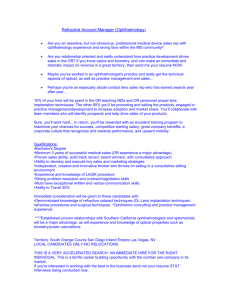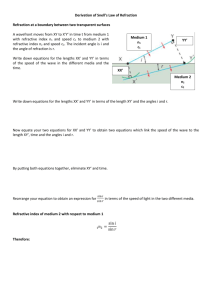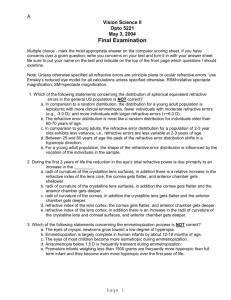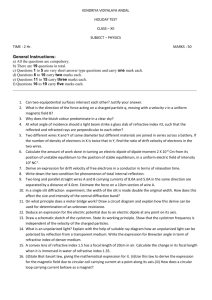VSII Final 2006
advertisement
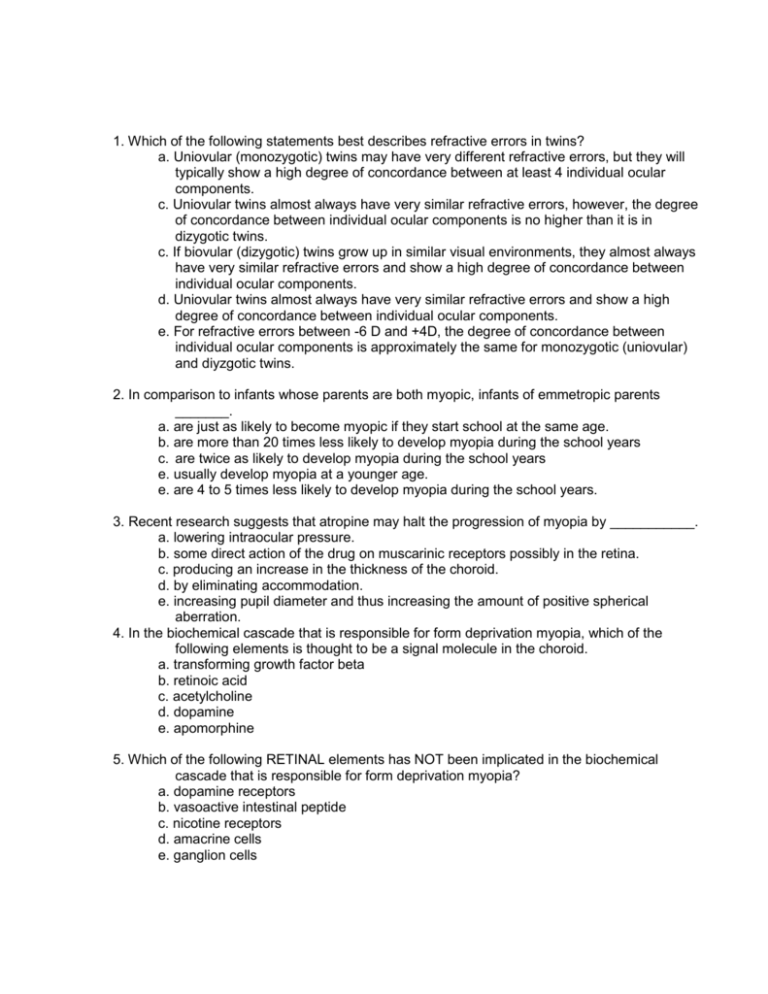
1. Which of the following statements best describes refractive errors in twins? a. Uniovular (monozygotic) twins may have very different refractive errors, but they will typically show a high degree of concordance between at least 4 individual ocular components. c. Uniovular twins almost always have very similar refractive errors, however, the degree of concordance between individual ocular components is no higher than it is in dizygotic twins. c. If biovular (dizygotic) twins grow up in similar visual environments, they almost always have very similar refractive errors and show a high degree of concordance between individual ocular components. d. Uniovular twins almost always have very similar refractive errors and show a high degree of concordance between individual ocular components. e. For refractive errors between -6 D and +4D, the degree of concordance between individual ocular components is approximately the same for monozygotic (uniovular) and diyzgotic twins. 2. In comparison to infants whose parents are both myopic, infants of emmetropic parents _______. a. are just as likely to become myopic if they start school at the same age. b. are more than 20 times less likely to develop myopia during the school years c. are twice as likely to develop myopia during the school years e. usually develop myopia at a younger age. e. are 4 to 5 times less likely to develop myopia during the school years. 3. Recent research suggests that atropine may halt the progression of myopia by ___________. a. lowering intraocular pressure. b. some direct action of the drug on muscarinic receptors possibly in the retina. c. producing an increase in the thickness of the choroid. d. by eliminating accommodation. e. increasing pupil diameter and thus increasing the amount of positive spherical aberration. 4. In the biochemical cascade that is responsible for form deprivation myopia, which of the following elements is thought to be a signal molecule in the choroid. a. transforming growth factor beta b. retinoic acid c. acetylcholine d. dopamine e. apomorphine 5. Which of the following RETINAL elements has NOT been implicated in the biochemical cascade that is responsible for form deprivation myopia? a. dopamine receptors b. vasoactive intestinal peptide c. nicotine receptors d. amacrine cells e. ganglion cells 6. Which of the following statements concerning the visual feedback loop that regulates refractive development is most correct?. a. The pathway goes through the visual cortex because both eyes always change in a coordinated manner. b. The efferent portion of the feedback loop goes through the ciliary ganglion. c. The visual signals go through the superior colliculus. d. Eye growth is controlled by mechanisms that are contained entirely within the eye. e. The ciliary body is a critical element the efferent portion of the feedback loop. 7. Longitudinal studies of refractive error have demonstrated that from birth to about 12 months of age ____________. a. children with with-the-rule astigmatism almost always become more myopic/less hyperopic. b. there is a strong tendency for myopic eyes to become clinically emmetropic, but hyperopic eyes typically show no systematic changes in refractive error. c. there is a strong tendency for both myopic and hyperopic eyes to become clinically emmetropic. d. it is not possible to predict changes in refractive error during the first year of life because of the large inter-subject variability in growth patterns. e. there is a strong tendency for hyperopic eyes to become clinically emmetropic, but myopic eyes typically show no systematic changes in refractive error. 8. Which of the following statements best summarizes the corneal changes in a normal adult between the ages of 35 and 55 years? a. There is an overall decrease in radius of curvature and the horizontal meridian changes more than the vertical meridian. b. There is an equal increase in radius of curvature for all corneal meridians. c. There is an overall decrease in radius of curvature and the vertical meridian changes more than the horizontal meridian. d. There is an equal decrease in radius of curvature for all corneal meridians. e. There is a selective increase in the radius of curvature of the vertical meridian. 9. After about 65 to 70 years of the age the average refractive error becomes __________. a. more myopic as a result of an increase in vitreous chamber depth b. less hyperopic/more myopic due to an increase in the refractive index of the nucleus of the crystalline lens. b. less hyperopic/more myopic due to a decrease in the refractive index of the crystalline lens cortex. d. more hyperopic/less myopic due to a decrease in anterior chamber depth. e. more hyperopic/less myopic due to an increase in the refractive index of the crystalline lens cortex. 10. Which of the following statements is NOT correct? a. During the rapid phase of emmetropization the rate of change in refractive error (e.g., D/month) is very similar in all infants. b. The distribution of refractive errors for a population of full-term neonates is approximately Gaussian in shape. c. On average, the eyes of most children become more isometropic during emmetropization. d. Anisometropia below 1.5 D is frequently transient during emmetropization. e. Emmetropization is largely complete in human infants by about 12-18 months of age. 11. During the first 3 years of life the reduction in the eye’s total refractive power is due primarily to an increase in the ________. a. refractive index of the lens cortex, in addition there is an increase in the radii of curvature of the crystalline lens and corneal surfaces, and the anterior chamber gets deeper. b. radius of curvature of the cornea, in addition the crystalline lens gets flatter and the anterior chamber gets deeper. c. radii of curvature of the crystalline lens surfaces, in addition there is a relative increase in the refractive index of the lens core, the cornea gets flatter, and anterior chamber gets shallower. d. refractive index of the lens cortex, the cornea gets flatter, and anterior chamber gets deeper. e. radii of curvature of the crystalline lens surfaces, in addition the cornea gets flatter and the anterior chamber gets deeper. 12. Which of the following statements concerning the effects of moderate powered spectacle lenses on emmetropization in young monkeys is NOT correct? a. Infant monkey can alter the relative axial growth rates of the 2 eyes to compensate for small degrees of anisometropia. b. Moderate powered lenses that provide clear vision in the unaccommodated state appear to slow down axial growth. c. Positive lenses which correct for the normal hyperopia found in young infants appear to prevent the normal reduction in hyperopia associated with emmetropization. d. Infant monkey can only recover from refractive errors produced by negative lenses. e. Negative lenses accelerate vitreous chamber growth. 13. Which of the following statements concerning the refractive characteristics of the eye is NOT correct? a. The range of axial lengths found in individuals with -1 D refractive errors is usually within the range observed in a large population of emmetropes. b. Young adults with hyperopic refractive errors larger than +6 D typically exhibit axial lengths that are shorter than those found in a population of emmetropes. c. The frequency distribution of refractive error in a normal young adult population is leptokurtic in shape. d. The frequency distribution of corneal powers in a normal young adult population is approximately Gaussian in shape. e. none of the above; all of the statements are correct. 14. Which of the following observations/findings has provided the strongest evidence that genetic factors play a key role in determining the eye’s refractive status? a. Parental history of myopia is a significant risk factor for myopia. b. The high correlation of refractive errors in identical twins. c. The different prevalence rates for myopia observed between Caucasian and Asian populations. d. The discovery of specific gene mutations associated with myopia. e. The discovery of the phenomenon of form-deprivation myopia. 15. Which of the following statements concerning form deprivation myopia (FDM) is NOT correct? a. FDM occurs in many species including humans. b. FDM is primarily due to vitreous chamber elongation. c. FDM requires abnormal visual retinal images and not simply an absence of light. d. FDM is a graded phenomenon; in general the greater the decrease in retinal image contrast, the greater the degree of FDM. e. None of the above; all the statements are correct 16. In comparison to an average adult emmetrope, the average adult myopic eye has ______? a. a lower refractive index for the cornea. b. a shallower vitreous chamber. c. a shallower anterior chamber. d. a flatter cornea. e. none of the above. 17. In comparison to normal full-term infants, premature infants typically exhibit a higher prevalence of _____________. a. hyperopia b. myopia c. oblique astigmatism d. with-the-rule astigmatism e. against-the-rule astigmatism 18. Which of the following statements concerning astigmatism is NOT correct? a. Most infants show an overall increase in astigmatism between birth and 6 months of age. b. Astigmatism in 6 month old infants primarily exists because the corneal is toroidal in shape. c. After age 45 years, most individual slowly develop more aganst-the-rule astigmatism or less with-the-rule astigmatism. d. Infants with 1 to 2 D of against-the-rule astigmatism at 9 months of age usually sho the same degree of astigmatism at 10 years of age. e. None of the above; all the statements are correct. 19. Which of the following statements concerning the operational properties of the visiondependent mechanisms that regulate refractive development is NOT correct? a. The nonlinear temporal integration properties of the emmetropization process normally reduce the likelihood that the eye will become myopic. b. The potential for a clear retinal image is essential for normal emmetropization. c. In order to produce axial myopia, the eye only has to experience form deprivation for approximately half the daily light cycle. d. The performance properties of the emmetropization process are qualitatively similar across many species. e. Vision-dependent mechanisms are probably active well into early adult life. 20. Which of the following statements concerning the operational properties of the visiondependent mechanisms that regulate refractive development is correct? a. A functioning fovea is essential for emmetropization. b. Peripheral vision can influence foveal refractive development. c. Visual signals from the fovea are essential for the phenomenon of form deprivation myopia. d. Peripheral image degradation will distort the shape of the eye without producing myopia at the fovea. e. None of the above. 21. Which of the following statements concerning early ocular and refractive development is NOT correct? a. The average refractive error for a normal, full-term infant is about +2.5 D of hyperopia. b. The variance of refractive errors in the population is lower at 3-5 years of age than at 20-25 years of age. c. The myopia observed in premature infants is associated with relatively long vitreous chamber depths. d. Corneal power reaches adult-like values at an earlier age than crystalline lens power. e. None of the above; all of the statements are correct. 22. Which of the following statements describes the refractive error distribution for the young adult population? a. The distribution is leptokurtic with more clinical emmetropes, fewer individuals with moderate refractive errors (e.g., -3.0 D), and more individuals with larger refractive errors (>+6.0 D) than predicted on the basis of chance. b. The distribution is platykurtic because there are more clinical emmetropes than predicted on the basis of chance. c. The distribution is leptokurtic with more clinical emmetropes, more individuals with moderate refractive errors (e.g., -3.0 D), and fewer individuals with larger refractive errors (>+6.0 D) than predicted on the basis of chance. d. The distribution is leptokurtic with more clinical emmetropes, fewer individuals with moderate refractive errors (e.g., -3.0 D), and fewer individuals with larger refractive errors (>+6.0 D) than predicted on the basis of chance. e. None of the above are correct. 23. For the average individual, which of the following ocular properties are most likely to show systematic changes between 5 and 10 years of age? a. corneal power and refractive error b. lens power and corneal power c. vitreous chamber depth and corneal power d. vitreous chamber depth and lens power e. refractive error and vitreous chamber depth. 24. Which of the following statements concerning juvenile onset myopia in the average US population is correct? a. The average progression rate is about 1.0 D per year. b. The onset of myopia is typically before 8 years of age. c. In general, the earlier the onset of myopia, the slower the rate of progression. d. The rate of myopic progression is inversely correlated with the rate of corneal flattening. e. None of the above 25. Which of the following predictive statements is most correct? a. Children who have hyperopic errors greater than +1.5 D at age 6 years will typically stay hyperopic. b. Children who have hyperopic error between +0.5 and +1.5 D at age 6 years will typically become clinically emmetropic. c. Children who have refractive errors less hyperopic/more myopic than +0.5 at age 6 years will typically become myopic in the next 5-6 years. d. a and b are correct e. all of the above are correct 26. Which of the following changes is NOT thought to contribute to the slow refractive error shift that occurs between the ages 40 and 65 years? a. a decrease in anterior chamber depth b. a decrease in vitreous chamber c. the onset of presbyopia d. an increase in the radius of curvature of the anterior and posterior lens surfaces. e. an increase in the refractive index of the lens cortex. 27. Which of the following statements concerning the role of accommodation in emmetropization and the development of refractive errors is correct? a. Chronic stimulation of accommodation with pilocarpine results in axial myopia in monkeys. b. Accommodation has an indirect effect on refractive development via its influence on the eye’s retinal image quality. c. Studies in monkeys have shown that prolonged accommodation during near work produces axial myopia. d. The fact that bifocals slow the progression of myopia demonstrates that accommodation plays a key role in the genesis of myopia. e. The fact that the average refractive error becomes more hyperopic with the onset of presbyopia indicates that accommodation prevents hyperopia and promotes myopia. 28. Which of the following statements concerning the implications of lens-rearing experiments in laboratory animals on the phenomenon of emmetropization is NOT correct? a. The emmetropization process has a limited operating range and refractive errors that fall outside this range produce unpredictable growth. b. The eye uses visual feedback associated with the eye’s effective refractive status to guide ocular growth toward emmetropia. c. In agreement with animal studies, clinical studies have demonstrated that “undercorrecting” young myopes reduces the progression of axial myopia. e. Emmetropization comes about primarily as a result of vision-dependent control over axial growth. e. None of the above; all of the statements are correct 29. Which of the following statements concerning treatment strategies for myopia is NOT correct? a. Recent studies have shown that progressive addition lenses actually accelerate the progression rate of myopia. b. Topically applied anti-glaucoma drugs that reduce intraocular pressure do not prevent or slow down the progression of myopia. c. Pirenzepine is a relatively selective cholinergic muscarinic antagonist that has been shown to slow the progression of juvenile onset myopia in a dose dependent fashion. d. There is little evidence that prescribing base-in prism for near work reduces the progression of juvenile onset myopia. e. none of the above; all of the statements are correct 30. Which of the following statements concerning the shape of emmetropic eyes of young adults is correct? a. Corneal power is usually negatively correlated with crystalline lens power. b. Corneal power is usually positively correlated with axial length. c. There is a high negative correlation between total power and axial length. d. Crystalline lens power is usually negatively correlated with axial length. e. Crystalline lens power is usually negatively correlated with corneal power.
